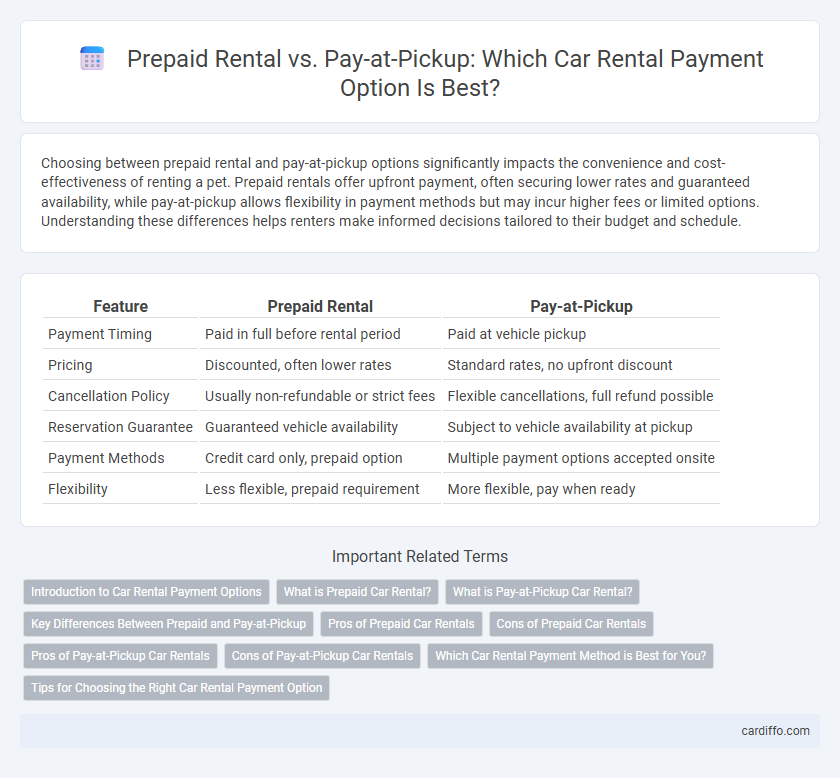Choosing between prepaid rental and pay-at-pickup options significantly impacts the convenience and cost-effectiveness of renting a pet. Prepaid rentals offer upfront payment, often securing lower rates and guaranteed availability, while pay-at-pickup allows flexibility in payment methods but may incur higher fees or limited options. Understanding these differences helps renters make informed decisions tailored to their budget and schedule.
Table of Comparison
| Feature | Prepaid Rental | Pay-at-Pickup |
|---|---|---|
| Payment Timing | Paid in full before rental period | Paid at vehicle pickup |
| Pricing | Discounted, often lower rates | Standard rates, no upfront discount |
| Cancellation Policy | Usually non-refundable or strict fees | Flexible cancellations, full refund possible |
| Reservation Guarantee | Guaranteed vehicle availability | Subject to vehicle availability at pickup |
| Payment Methods | Credit card only, prepaid option | Multiple payment options accepted onsite |
| Flexibility | Less flexible, prepaid requirement | More flexible, pay when ready |
Introduction to Car Rental Payment Options
Prepaid rental options require customers to pay the entire rental cost upfront, often offering discounted rates and guaranteed vehicle availability. Pay-at-pickup allows renters to pay upon vehicle collection, providing flexibility but sometimes at higher prices with potential additional fees. Choosing between these payment methods depends on budget preferences, travel plans, and the desire for cost savings or payment convenience in car rental services.
What is Prepaid Car Rental?
Prepaid car rental requires customers to pay the full rental amount upfront, often at a discounted rate compared to pay-at-pickup options. This payment method secures the reservation, reduces paperwork at pickup, and typically offers better cancellation policies. Prepaid rentals benefit travelers seeking cost certainty and streamlined vehicle collection at airports or city locations.
What is Pay-at-Pickup Car Rental?
Pay-at-pickup car rental allows customers to reserve a vehicle without immediate payment, completing the transaction upon arrival at the rental location. This option provides flexibility for travelers who prefer to inspect the car or finalize payment details in person. Rental companies often require a valid credit card at pickup to cover the estimated rental charges and potential incidental fees.
Key Differences Between Prepaid and Pay-at-Pickup
Prepaid rental requires the full payment upfront, securing the reservation and often offering lower rates or discounts, while pay-at-pickup allows customers to pay upon vehicle collection, providing flexibility but sometimes at higher costs. Prepaid rentals typically reduce the risk of cancellations and guarantee vehicle availability, whereas pay-at-pickup rentals may involve deposits and potential price changes at the time of pickup. Understanding these differences helps renters choose the best payment method based on budget, convenience, and commitment level.
Pros of Prepaid Car Rentals
Prepaid car rentals often provide significant cost savings with discounted rates compared to pay-at-pickup options, making them ideal for budget-conscious travelers. This payment method guarantees a reserved vehicle, reducing the risk of no availability and ensuring a smoother pickup process. Customers benefit from quicker transactions as prepaid rentals minimize paperwork and payment steps upon arrival at the rental location.
Cons of Prepaid Car Rentals
Prepaid car rentals often lack flexibility, as customers may face strict cancellation policies and non-refundable deposits, leading to potential financial losses if plans change. They typically offer limited options for upgrades or changes at pickup, restricting customization based on real-time needs. Confusion over final charges can arise due to additional fees not covered in the prepaid amount, causing unexpected expenses at the rental counter.
Pros of Pay-at-Pickup Car Rentals
Pay-at-pickup car rentals offer flexibility by allowing customers to pay only when they collect the vehicle, reducing upfront financial commitment. This payment method permits easier modifications or cancellations without losing initial deposits, enhancing customer convenience. It also enables renters to verify the vehicle's condition and ensure it meets expectations before making the full payment, increasing satisfaction and trust.
Cons of Pay-at-Pickup Car Rentals
Pay-at-pickup car rentals often result in higher overall costs due to last-minute price adjustments and limited time for price comparison. This payment method can lead to longer wait times at the rental counter, increasing inconvenience and potentially causing delays. Customers may also face unexpected fees or charges that are only disclosed during the pickup process, reducing transparency and complicating budgeting.
Which Car Rental Payment Method is Best for You?
Prepaid rental offers a secure way to lock in rates and avoid last-minute price changes, making it ideal for travelers seeking budget certainty and convenience. Pay-at-pickup provides flexibility, allowing renters to choose or upgrade vehicles on arrival without upfront commitment, often benefiting those with evolving plans. Evaluating your travel itinerary, payment preferences, and cancellation policies will help determine whether prepaid rental or pay-at-pickup aligns best with your needs.
Tips for Choosing the Right Car Rental Payment Option
Choosing between prepaid rental and pay-at-pickup options depends on budget flexibility and cancellation policies. Prepaid rentals often offer lower rates and guaranteed prices but may come with strict cancellation fees, while pay-at-pickup allows more flexibility in payment and potential last-minute changes. Analyze your travel plans, compare total costs including potential penalties, and verify insurance and refund conditions to select the best car rental payment option.
Prepaid Rental vs Pay-at-Pickup Infographic

 cardiffo.com
cardiffo.com